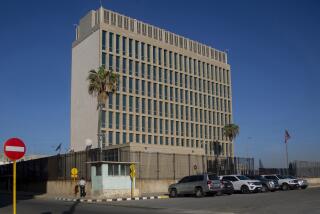Panel says vaccine, pesticides caused Gulf War syndrome
- Share via
A congressionally mandated scientific panel has concluded that Gulf War syndrome is real and still afflicts nearly a quarter of the 700,000 U.S. troops who served in the 1991 conflict, according to a report released Monday.
The report broke with most earlier studies by concluding that two chemical exposures were direct causes of the disorder: the drug pyridostigmine bromide, given to troops to protect against nerve gas, and pesticides that were widely used -- and often overused -- to protect against sand flies and other pests.
“The extensive body of scientific research now available consistently indicates that Gulf War illness is real, that it is a result of neurotoxic exposures during Gulf War deployment, and that few veterans have recovered or substantially improved with time,” according to the 450-page report presented to Secretary of Veterans Affairs James Peake.
The report bolstered the hopes of thousands of U.S. and allied veterans who have struggled to have their varied neurological symptoms, including memory loss, concentration problems, rashes and widespread pain, recognized by the government.
“I’ve had vets go to the VA and be turned away and told that this is something that doesn’t exist,” said John Schwertfager, vice president of the National Gulf War Resource Center, a veterans advocacy group.
But some scientists were not convinced that the new report had found the long-sought smoking gun.
“Even though we know that the Department of Defense did ship pesticides, it doesn’t mean that the people who were exposed to them were the ones who ended up having symptoms,” said Dr. Lynn Goldman, a professor of environmental health sciences at Johns Hopkins University in Baltimore who has worked on previous reports on the illness. “We felt that there needed to be better records of where people were, what they were exposed to and their prior health status going in.”
The new report is the product of the Research Advisory Committee on Gulf War Veterans’ Illnesses, which was chartered by Congress because many members thought that veterans were not receiving adequate care. On the 15-member committee appointed in 2002, scientists made up about two-thirds and the rest were veterans.
Several reports had already been issued by the prestigious Institute of Medicine, an arm of the National Academy of Sciences, blaming stress and other unknown causes for the soldiers’ symptoms.
“There’s something about going to the Gulf and serving in the Gulf that has caused something bad and persistent and real, but we have not found any evidence for a specific cause,” said Dr. Harold C. Sox, chairman of a 2000 institute study and editor of the journal Annals of Internal Medicine.
Veterans blame the institute’s reports for the difficulties they’ve faced in getting treatment for their problems.
“Everyone quotes the Institute of Medicine documents as meaning nothing’s going on here,” said Roberta F. White, associate dean of research at the Boston University School of Public Health and the congressional panel’s scientific director. “Some people feel that the IOM reports have been permission to ignore these guys.”
The new report cites dozens of research studies that have identified “objective biological measures” that distinguish veterans with the illness from healthy controls.
The major causes of the disorder appear to be self-inflicted. Pyridostigmine bromide was given to as many as half of the troops in the fear that the Iraqis would unleash chemical warfare against them.
According to the report, at least 64 pesticides containing 37 active ingredients were used during the war. They were sprayed not only around living and dining areas, but also on tents and uniforms, White said.
There was less evidence to support a link to the U.S. demolition of Iraqi munitions near Khamisiyah, which may have exposed about 100,000 troops to nerve gases stored at the facility, according to the panel.
The panel said it could not rule out a link between the illness and exposure to oil well fires and multiple vaccinations. But it could find no evidence linking it to depleted uranium shells, anthrax vaccine and infectious diseases.
In addition to increased rates of memory loss, fatigue and pain, Gulf War veterans have higher rates of brain cancer and amyotrophic lateral sclerosis, or Lou Gehrig’s disease, the panel also noted.
The panel called on Congress to appropriate $60 million a year to conduct research into finding a cure for the disorder.
“The tragedy here is that there are currently no treatments,” said the panel’s chairman, James H. Binns, a former principal deputy assistant secretary of Defense and a Vietnam veteran.
Binns emphasized that the report was not written to yield recriminations about past actions.
“The importance . . . lies in what is done with it in the future,” he said. “It’s a blueprint for the new administration.”
--
thomas.maugh@latimes.com
More to Read
Sign up for Essential California
The most important California stories and recommendations in your inbox every morning.
You may occasionally receive promotional content from the Los Angeles Times.










